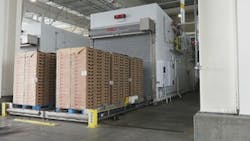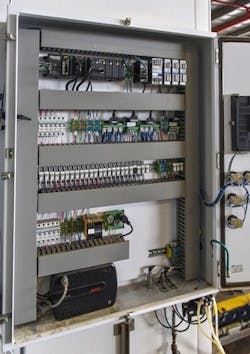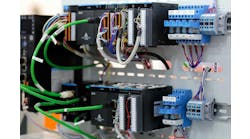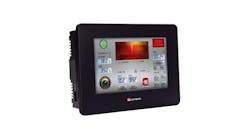Perishable fresh vegetables and fruit, such as strawberries, must be sold within two days or less of harvesting to meet quality requirements. This perishable produce spoils even more quickly if not precooled immediately after harvest.
Figure 1: With more than 2.3 billion pounds of strawberries harvested every year in California, strawberry farms are a common sight in the region.
(Source: Hawkins Engineering)
The post-harvest cooling process is critical for maintaining product quality and extending shelf-life for strawberries and other produce. Strawberries need to make it to market, because per the California Department of Food and Agriculture, the value of California’s strawberry crop is approximately $2.6 billion annually, making it the fifth most valuable fruit crop produced in California. That’s more than 2.3 billion pounds of strawberries per year (Figure 1).
There are a variety of precooling systems available to preserve the quality of perishable fresh fruit and vegetables after harvest. While there are five common methods, the focus of this case study is the Modular Automated Cooling System (MACS) Cooler. Built at MACS Cool and engineered at Hawkins Engineering, it is the fastest, automated, forced-air portable precooling system available.
MACS Coolers are designed for produce-precooling facilities needing to minimize precooler floor space and maximize productivity. New facilities have the greatest potential benefit. Since MACS Coolers can be positioned outside the cold storage facility, more building space can be dedicated to cold storage. This keeps the building costs down, as well as the refrigeration costs in many instances.
ALSO READ: Mini-PLCs—more than just a smart relay
Precooling Methods
The precooling process rapidly cools freshly harvested fruit and vegetables and is typically performed before produce is placed in cold storage or shipped to market. There are five common methods to precool produce:
- room cooling
- ice cooling
- hydro-cooling
- vacuum cooling
- forced-air cooling.
Some of the methods use low energy but are slow, such as room cooling. Others are faster processes but have some issues that affect the produce. For example, water used in hydro-cooling can spread pathogens, vacuum cooling can dehydrate the produce, and ice cooling can add weight. Each method has its own niche, but forced-air cooling works with the widest range of fruits and vegetables.
Forced-air cooling removes the heat from the produce by using a pressure differential across the pallets to draw cold air through them. Traditionally, conventional tarped cooling tunnels are used for precooling many varieties of palletized produce. This method involves using a cold room and plenum fans to draw cold air through the product, with each fan forming a tunnel.
Tarped cooling tunnels require the manual loading of pallets in two rows to make a tunnel that cold air is forced through. Once the pallets are lined up in rows, a tarp must be laid across the gap between the rows of pallets. Once the batch of pallets is finished cooling, the tarp must be lifted so the pallets can be moved to storage.
It’s a manual process to line up the pallets, and it’s difficult to know when the process has finished cooling. It is also difficult to reverse air flow because the tarps and pallets need to be removed and then rebuilt in reverse order.
The MACS Cooler is an automated forced-air cooler that does not require a tarp. MACS Coolers have inflatable seals that expand and retract automatically in seconds. Cooling tunnels can’t compete with the speed and efficiency of these systems, even with motorized tarp systems.
And while tarped cooling tunnels require the produce to be probed periodically to determine if it’s finished precooling, the MACS Cooler uses recipe product codes to automate the appropriate amount of cooling time.
Modular Automated Cooling System
The MACS Cooler is an automated produce-precooling system. A standard MACS Cooler has two cooling modules, each 24 ft long, enclosed by insulated panels. On one end is a pair of infeed roller conveyors, and outfeed roller conveyors are on the other end. Each module has two cooling zones, and each zone has its own roller conveyor. The only section that takes up space inside the refrigerated building is the outfeed section because the rest of the system is outside.
The MACS Cooler is portable via truck and trailer. A customer can transport a MACS Cooler among multiple locations based on seasonal needs. This is the case with Western Precooling Systems (WPS), a precooling provider with more than 100 sites throughout primary growing regions in the western United States. The Oxnard and Salinas growing regions in California have different strawberry seasons. WPS owns eight MACS Coolers, and their portability allows WPS to move units between two of their California facilities to accommodate the peak of each season.
Figure 2: The flow-through design of the MACS Cooler allows forklift operators to unload the pallets and set them on the MACS Cooler’s infeed conveyors located outside the building.
(Source: Hawkins Engineering)
The design of the MACS Coolers reduces labor costs and potential accidents because less time is spent handling the product pallets. To start, the product is pre-loaded on pallets and brought to a cooling facility, usually via flatbed truck, where one or more MACS Coolers are installed. The flow-through design of the MACS Cooler allows forklift operators to unload the pallets and set them on the MACS Cooler’s infeed conveyors located outside the building (Figure 2).
The MACS Cooler moves the pallets through the cooling zones until the product is at the desired temperature. The pallets are then moved by the outfeed conveyors located inside the cold room. The pallets on the outfeed conveyors are unloaded by forklift and stored or loaded onto a refrigerated truck. This drastically reduces forklift traffic in and out of the building, strengthening the cold chain. Existing facility owners who add a MACS Cooler benefit by expanding productivity without increasing the size of the refrigerated building.
Automation System Upgrade
Figure 3: The control platform’s looping and indirect addressing features reduced long, explicit logic rungs into elegant, short code statements.
(Source: Hawkins Engineering)
Version 1 of the MACS Cooler was installed in 2004. Eighty-five percent of the control system components were purchased directly from AutomationDirect (Figure 3). The system used the DL205 programmable logic controller (PLC) platform due to its size, performance and flexibility. Over time, as the MACS Cooler design matured and new features were added, more processing power was needed. The Do-more Series PLC was chosen as the next major control system upgrade because of its ability to work with the existing DL205 architecture and because of its expanded capabilities.
After porting the existing PLC program to the Do-more platform, the logic program ran much faster. The looping and indirect addressing features reduced long, explicit logic rungs into elegant, short code statements. The program became easier to use and read.
Customers noticed a marked improvement in HMI response, as well. After upgrading to the Do-more PLC and AutomationDirect’s C-more EA9 Series HMI Touch Panels, users noticed the HMI response time was nearly immediate.
Another marked improvement to the MACS design was the addition of the AutomationDirect ViewMarq industrial LED message display. This display was initially used to show the time until next move for the forklift drivers so they would know how soon they would be able to load more product. Additional upgrades added status information, and the display now tells a driver or operator what they need to know to stay productive, even from across the facility.
MACS Cool now sources all its automation components from AutomationDirect’s value-added reseller Quantum Automation in Anaheim, California. Most of the controls components are AutomationDirect, including the PLCs, HMIs, ViewMarq displays, relays, power supplies, motor starters, contactors, sensors, circuit breakers, DIN rail and terminal blocks.
System Operation Details
Figure 4: The product temperature is manually checked at the infeed and outfeed of the MACS Cooler and then entered into the HMI.
(Source: Hawkins Engineering)
The product pallet is loaded by forklift onto the MACS Coolers infeed roller conveyors. As pallets are set down, the PLC is programmed to stage them to make room for the next pallets to be loaded. After the product is set down, the driver or operator is prompted to take the pulp temperature of the product with a probe and then to enter this value at the HMI (Figure 4).
Once a full load of six pallets is on the infeed conveyor, the door raises and the internal seals lift. The product is then moved by the roller conveyors into the first cooling zone. Photo eyes are used to sense the pallet positions and trigger the PLC to stop the pallets at the correct location.
Once the pallets are positioned in the cooling zone, the seals inflate and press against the pallets, performing the same function as a tarp in conventional cooling tunnels, but with higher efficiency as the seal is better. Each zone has its own fan and refrigeration coil controlled by the PLC. The cold air is forced through the product, removing heat as it moves past the relatively warmer produce.
Temperature and pressure sensors monitor the cooling conditions. Recipe set points are configured for each product type to regulate fan speeds, temperatures, pressures and cooling time parameters. The MACS then cools the product for the designated amount of time per the entered pulp temperature and package type.
Pallet cooling time, in four-zone systems, is typically between seven and 45 minutes per zone based on product type and temperature programmed. Once the per-zone product cooling time expires, the refrigeration turns off, the seals are deflated, and the doors are opened. The pallets then move to Zone 2 and a new load of pallets, if available, are moved into Zone 1. With all the pallet loads shifted, the doors close and the seals inflate, and forced-air cooling begins again. The flow of air is reversed in Zone 2 and in each subsequent cooling zone to equalize the temperature throughout the pallets.
After a pallet load has moved through each of the cooling zones, usually four, it is moved to the outfeed roller conveyor section located inside the refrigerated building. A forklift driver takes the final product temperature with a probe and enters it into the HMI. The HMI compiles the temperature data along with load information such as product type, temperatures and cooling times. At the end of the cooling day, the plant manager receives this compiled data in a report via email.
Results at D’Arrigo Bros.
The MACS Coolers are being used successfully by the D’Arrigo Bros. of California (Andy Boy label), a fresh produce grower and distributor. The company was precooling and shipping only vegetables but wanted to precool and ship strawberries for Driscoll’s, a grower and seller of fresh strawberries and other berries.
D’Arrigo was using manual-tarped forced-air cooling tunnels to cool cauliflower. To add the strawberries, it would need 12 new tunnels to handle the first year’s volume, plus about 9,000 sq ft of refrigerated warehouse space. Instead, it chose to purchase two MACS Coolers because they were highly recommended by Driscoll’s, a long-time user of the product.
D’Arrigo and Driscoll’s were both extremely pleased with the results of the first season and decided to expand their contract to include more product for subsequent seasons. D’Arrigo ordered three more MACS Coolers and now cools and ships up to 1.2 million pounds of strawberries per day.
D’Arrigo did need to add 50,000 sq ft of refrigerated warehouse to handle increased volumes, but, if it had gone with manual tunnels instead of MACS Coolers, they would have needed an additional 23,000 sq ft. The MACS Coolers are also much more productive. Each unit can cool 24 pallets per hour, while conventional forced-air tunnels cool 8 to 10 pallets in a little more than hours. In addition to cooling faster, the MACS Coolers typically save customers 40-50% on energy cost per pallets cooled, as compared to the tarp-cooling systems, and this was the case for D’Arrigo.

Leaders relevant to this article:








